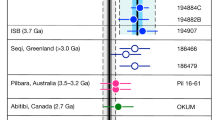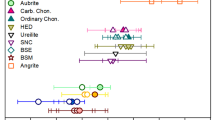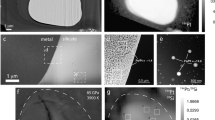Abstract
The excess of highly siderophile (iron-loving) elements (HSEs) and the chondritic ratios of most HSEs in the bulk silicate Earth (BSE) may reflect the accretion of a chondritic ‘late veneer’ of about 0.5 per cent of Earth’s mass after core formation1,2. The amount of volatiles contained in the late veneer is a key constraint on the budget and the origin of the volatiles in Earth. At high pressures and temperatures, the moderately volatile chalcogen elements sulphur (S), selenium (Se) and tellurium (Te) are moderately to highly siderophile; thus, if depleted by core formation their mantle abundances should reflect the volatile composition of the late veneer3,4. Here we report ratios and abundances of S, Se and Te in the mantle determined from new isotope dilution data for post-Archaean mantle peridotites. The mean S/Se and Se/Te ratios of mantle lherzolites overlap with CI (Ivuna-type) carbonaceous chondrite values5,6. The Se/Te ratios of ordinary and enstatite chondrites are significantly different. The chalcogen/HSE ratio of the BSE is similar to that of CM (Mighei-type) carbonaceous chondrites, consistent with the view that the HSE signature of the BSE reflects a predominance of slightly volatile-depleted, carbonaceous-chondrite-like material, possibly with a minor proportion of non-chondritic material7. Depending on the estimates for the abundances of water and carbon in the BSE8, the late veneer may have supplied 20 to 100 per cent of the budget of hydrogen and carbon in the BSE.
This is a preview of subscription content, access via your institution
Access options
Subscribe to this journal
Receive 51 print issues and online access
$199.00 per year
only $3.90 per issue
Buy this article
- Purchase on Springer Link
- Instant access to full article PDF
Prices may be subject to local taxes which are calculated during checkout



Similar content being viewed by others
References
Walker, R. J. Highly siderophile elements in the Earth, Moon and Mars: update and implications for planetary accretion and differentiation. Chem. Erde Geochem. 69, 101–125 (2009)
Mann, U., Frost, D. J., Rubie, D. C., Becker, H. & Audetat, A. Partitioning of Ru, Rh, Pd, Re, Ir and Pt between liquid metal and silicate at high pressures and high temperatures: implications for the origin of highly siderophile element concentrations in the Earth’s mantle. Geochim. Cosmochim. Acta 84, 593–613 (2012)
Yi, W. et al. Cadmium, indium, tin, tellurium, and sulfur in oceanic basalts: Implications for chalcophile element fractionation in the Earth. J. Geophys. Res. Solid Earth 105, 18927–18948 (2000)
Rose-Weston, L., Brenan, J. M., Fei, Y. W., Secco, R. A. & Frost, D. J. Effect of pressure, temperature, and oxygen fugacity on the metal-silicate partitioning of Te, Se, and S: implications for earth differentiation. Geochim. Cosmochim. Acta 73, 4598–4615 (2009)
Dreibus, G., Palme, H., Spettel, B., Zipfel, J. & Wänke, H. Sulfur and selenium in chondritic meteorites. Meteoritics 30, 439–445 (1995)
Lodders, K. Solar system abundances and condensation temperatures of the elements. Astrophys. J. 591, 1220–1247 (2003)
Fischer-Gödde, M. & Becker, H. Osmium isotope and highly siderophile element constraints on ages and nature of meteoritic components in ancient lunar impact rocks. Geochim. Cosmochim. Acta 77, 135–156 (2012)
Marty, B. The origins and concentrations of water, carbon, nitrogen and noble gases on Earth. Earth Planet. Sci. Lett. 313–314, 56–66 (2012)
Abe, Y., Ohtani, E., Okuchi, T., Righter, K. & Drake, M. in Origin of the Earth and Moon (eds R. M. Canup & K. Righter) 413–433 (Univ. Arizona Press, 2000)
Wood, B. J., Walter, M. J. & Wade, J. Accretion of the Earth and segregation of its core. Nature 441, 825–833 (2006)
Schönbächler, M., Carlson, R. W., Horan, M. F., Mock, T. D. & Hauri, E. H. Heterogeneous accretion and the moderately volatile element budget of Earth. Science 328, 884–887 (2010)
Rubie, D. C. et al. Heterogeneous accretion, composition and core-mantle differentiation of the Earth. Earth Planet. Sci. Lett. 301, 31–42 (2011)
Albarède, F. Volatile accretion history of the terrestrial planets and dynamic implications. Nature 461, 1227–1233 (2009)
Wood, B. J. & Halliday, A. N. The lead isotopic age of the Earth can be explained by core formation alone. Nature 465, 767–770 (2010)
Becker, H. et al. Highly siderophile element composition of the Earth's primitive upper mantle: constraints from new data on peridotite massifs and xenoliths. Geochim. Cosmochim. Acta 70, 4528–4550 (2006)
Fischer-Gödde, M., Becker, H. & Wombacher, F. Rhodium, gold and other highly siderophile elements in orogenic peridotites and peridotite xenoliths. Chem. Geol. 280, 365–383 (2011)
Walker, R. J. et al. Comparative 187Re-187Os systematics of chondrites: implications regarding early solar system processes. Geochim. Cosmochim. Acta 66, 4187–4201 (2002)
Meisel, T., Walker, R. J., Irving, A. J. & Lorand, J. P. Osmium isotopic compositions of mantle xenoliths: a global perspective. Geochim. Cosmochim. Acta 65, 1311–1323 (2001)
Morgan, J. W. Ultramafic xenoliths: clues to Earth’s late accretionary history. J. Geophys. Res. Solid Earth 91, 12375–12387 (1986)
McDonough, W. F. & Sun, S. S. The composition of the Earth. Chem. Geol. 120, 223–253 (1995)
Palme, H. & O’Neill, H. S. C. in Treatise on Geochemistry Vol. 2 (eds H. D. Holland & K. K. Turekian) 1–38 (Pergamon, 2003)
Lorand, J. P. & Alard, O. Determination of selenium and tellurium concentrations in Pyrenean peridotites (Ariege, France): new insight into S/Se/Te systematics of the upper in mantle samples. Chem. Geol. 278, 120–130 (2010)
Wang, Z., Becker, H. & Gawronski, T. Partial re-equilibration of highly siderophile elements and the chalcogens in the mantle: a case study on the Baldissero and Balmuccia peridotite massifs (Ivrea Zone, Italian Alps). Geochim. Cosmochim. Acta 108, 21–44 (2013)
Bodinier, J. L. & Godard, M. in Treatise on Geochemistry Vol. 2 (eds H. D. Holland & K. K. Turekian) 103–170 (Pergamon, 2003)
Lyubetskaya, T. & Korenaga, J. Chemical composition of Earth’s primitive mantle and its variance: 1. Method and results. J. Geophys. Res. Solid Earth 112, B03211 (2007)
Alexander, C. M. O. D. et al. The provenances of asteroids, and their contributions to the volatile inventories of the terrestrial planets. Science 337, 721–723 (2012)
Bottke, W. F., Walker, R. J., Day, J. M. D., Nesvorny, D. & Elkins-Tanton, L. Stochastic late accretion to Earth, the Moon, and Mars. Science 330, 1527–1530 (2010)
Jenner, F. E. & O'Neill, H. S. C. Analysis of 60 elements in 616 ocean floor basaltic glasses. Geochem. Geophys. Geosyst. 13, Q02005 (2012)
König, S., Luguet, A., Lorand, J.-P., Wombacher, F. & Lissner, M. Selenium and tellurium systematics of the Earth’s mantle from high precision analyses of ultra-depleted orogenic peridotites. Geochim. Cosmochim. Acta 86, 354–366 (2012)
Hertogen, J., Janssens, M. J. & Palme, H. Trace elements in ocean ridge basalt glasses: implications for fractionations during mantle evolution and petrogenesis. Geochim. Cosmochim. Acta 44, 2125–2143 (1980)
Fehr, M. A., Rehkämper, M. & Halliday, A. N. Application of MC-ICPMS to the precise determination of tellurium isotope compositions in chondrites, iron meteorites and sulfides. Int. J. Mass Spectrom. 232, 83–94 (2004)
Acknowledgements
Some peridotite and meteorite samples were provided by S. Gao, J.-P. Lorand, G. MacPherson and M. Wadhwa. We thank F. Wombacher and C. Funk for discussions and M. Feth, K. Hammerschmidt and M. Weynell for technical assistance. This work was supported by funds from Freie Universität Berlin and a China Scholarship Council fellowship to Z.W.
Author information
Authors and Affiliations
Contributions
Z.W. and H.B. wrote the paper. H.B. designed the project. Z.W. developed the analytical methods and performed the analyses.
Corresponding authors
Ethics declarations
Competing interests
The authors declare no competing financial interests.
Supplementary information
Supplementary Information
This file contains Supplementary Text and Data, a Supplementary Discussion, Supplementary Figures 1-2 and Supplementary References. (PDF 416 kb)
Supplementary Tables
This file contains Supplementary Tables 1-7. (XLS 78 kb)
Rights and permissions
About this article
Cite this article
Wang, Z., Becker, H. Ratios of S, Se and Te in the silicate Earth require a volatile-rich late veneer. Nature 499, 328–331 (2013). https://doi.org/10.1038/nature12285
Received:
Accepted:
Published:
Issue Date:
DOI: https://doi.org/10.1038/nature12285
Comments
By submitting a comment you agree to abide by our Terms and Community Guidelines. If you find something abusive or that does not comply with our terms or guidelines please flag it as inappropriate.



